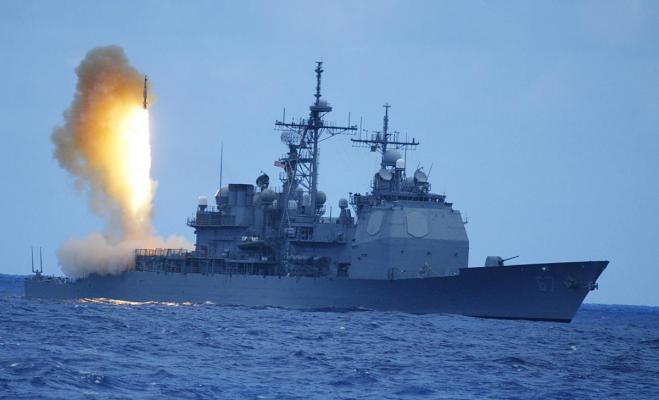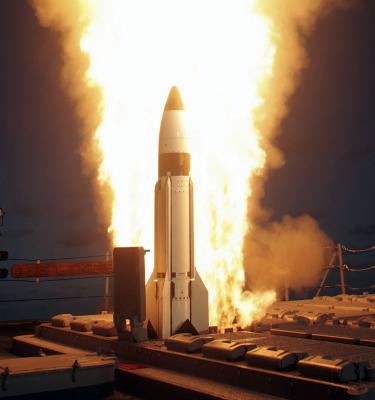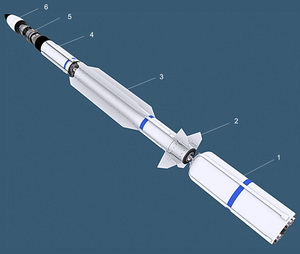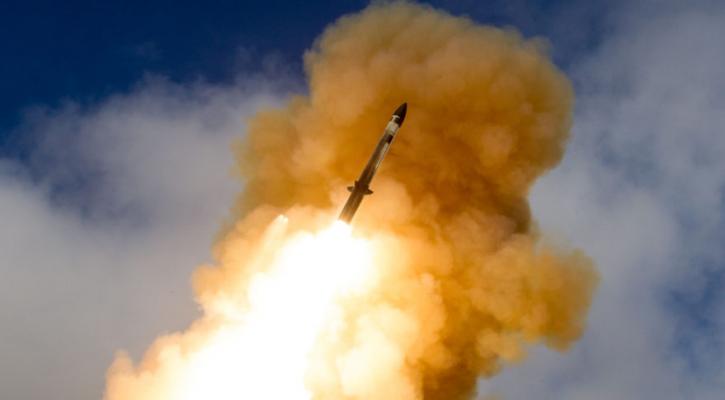Standard-3 ( SM-3/ RIM-161) - American antiaircraft guided missile family Standard, is part of the ship-based missile defense system and is designed to intercept medium- and short-range ballistic missiles in the upper atmosphere and in the zaatmosfernom section.
The ship-based missile defense system is based on the upgraded Aegis multifunctional combat control system. This system is equipped with the Arleigh Burke and Zumwalt destroyers, some of the U.S. Navy Ticonderoga cruisers. SM-3 missiles under Aegis control are also deployed on ships of similar purpose of the Japanese Navy (Kongo class destroyers), Spain (F100 class frigates), South Korea (KDX-3 class destroyers), Australia and Norway (F-314 type frigates).
The SM-3 missile is a development of the long-range SM-2 Block IV (RIM-156) anti-aircraft missile, created in the early 1990s by Raytheon. The first test launch of SM-3 took place on September 24, 1999. Work on the modernization of SM-3 began even before the start of testing and is still ongoing. The main stages of modernization and prospective development of the missile were designated SM-3 Block IA, SM-3 Block IB, SM-3 Block IIA, SM-3 Block IIB.
As of 2012, 129 missiles have been delivered to the U.S. Navy (mainly in Block I/IA variants), a total of 678 missiles are planned to be delivered by 2020, and the number of destroyers capable of carrying SM-3 will increase to 32.
In parallel with the modernization of the missile itself, active work is underway to integrate SM-3 with other combat control and detection systems. Raytheon announced it has completed the development of a prototype equipment for a dual-band data line that will enable the full range of SM-3 interceptor missiles to be used by ships equipped with Aegis and SMART-L/APAR airborne target detection radars. The naval forces of Denmark, France, Germany, Italy, the Netherlands, Norway, Spain and the United Kingdom have more than 20 ships equipped with Thales SMART-L/APAR radars. The ability to integrate the SM-3 interceptor missiles with the SMART-L/APAR radars provides a fundamental opportunity to use them as part of a single missile defense system.
In 2013 it was published information on completion of works on integration of Aegis with HAVELSAN maritime battle control system of Turkey.
The Aegis combat control system is also being improved. The second generation Aegis BMD 4.0.1 system is equipped with a new signal processor and provides a joint solution of air and missile defense tasks. As of 2012, the Aegis BMD 4.0.1 system is equipped with a new signal processor and provides a joint solution for air and missile defense tasks. Aegis BMD 4.0.1 was deployed on board two U.S. Navy ships and is scheduled for service in 2014.
The prospective Aegis BMD 5.1 will be able to use all missiles of the Standard family and have the ability to intercept intercontinental ballistic missiles. Aegis BMD 5.1 will be in service after 2020.
Composition:
The missile defense complex includes:
- AEGIS Combat Control System:
- radar AN/SPY-1D(V);
- fire control system Mk 99;
- a ship-wide computer system with 24 AN/UYK-7 and AN/UYK-20 computers;
- display devices like AN/UYK-4 (or AN/UYQ-21);
- 4 indicators of generalized tactical situation;
- hydroacoustic complex;
- radio electronic system on board the helicopter;
- digital LINK-11 communication lines;
- E-2S Hawkeye long-range radar observation and control deck aircrafts, S-3 Viking anti-submarine deck aircrafts and Orion base patrol R-ZS.
- SM-3 missile (RIM-161)
- Vertical Launching Unit (VLU) Mk41;
SM-3 has the same mass dimensional characteristics as SM-2 Block IV. The length of both rockets is 6.59 m, the diameter of the accelerator - 533 mm, the diameter of the march stage - 343 mm, mass - 1500 kg. Both missiles are equipped with the same solid-fuel accelerator Mk 72 with a four-nozzle block, acceleration and marching two-mode engines Mk 104, wings of ultra-small elongation and opening block of aerodynamic rudders.
The difference between SM-2 and SM-3 is the installation of a third stage on SM-3, which includes:
- precoaster motor Mk 136,
- inertial guidance section with GPS receiver and data exchange line,
- lightweight dumpable fairing,
- Intercept stage Mk 142, which destroys the target by direct hit.
The Ìk 136 is a solid fuel double-start motor developed by Alliant Techsystems. It is equipped with two solid fuel charges separated by a barrier system, and its design is made of graphite epoxy and carbon-carbon composite materials. The engine run time is 30 seconds. To ensure stabilization and orientation of the third stage of the rocket during the autonomous flight, the engine includes an integrated control system that uses cold gas as a working body.
The Mk 142 intercept stage is a self-propelled device with a cryogenic IR-GSN matrix, several processors, a solid fuel propulsion system for maneuvering and orientation (DACS), a power supply and a number of other subsystems on board.
Advertising in the initial stages of the work, Raytheon reported that the range of infrared GHN target detection is more than 300 km, and the use of DACS allows you to deflect the trajectory of its flight at a distance of more than 3-3.2 km.
The creation of such a small-size propulsion system was one of the results of a program launched in the mid-1980s to implement critical missile defense technologies. At that time a number of leading American companies were involved in its implementation on a competitive basis. As a result, by the early 1990s Boeing, the leader in this work, had created the "lightest in the world" (weighing less than 5 kg) propulsion system. It consists of a solid fuel gas generator equipped with several charges, a nozzle block and high-speed (up to 200 Hz) valves, capable of operating at a temperature of 2040 ° C. As noted, the creation of such a design required the use of special heat-resistant materials, in particular, based on rhenium.
SM-3 is launched from the Mk41 vertical starter, designed for ships equipped with the Aegis system.
Work was carried out to adapt SM-3 rockets for use with ground-based launchers. This version of SM-3 was first proposed by Raytheon in 2003 and was initially developed on a proactive basis. As an option, the developer company proposes integrating the ground-based SM-3 into the THAAD missile defense system.
SM-3 Block IA
The first variant of SM-3 missile modernization was SM-3 Block IA, which had small improvements in the design of the intercept stage. Flight tests of SM-3 Block IA began on June 22, 2006, during which a number of successful ballistic target intercepts were performed at various points in the trajectory. In addition to the U.S. Navy ships equipped with the Aegis system, a number of these tests involved Japanese, Dutch, and Spanish ships.
The "standard" range and intercept altitude of SM-3 Block IA are reported to be 600 and 160 km, respectively, with a maximum speed of 3-3.5 km/s, which provides the kinetic impact energy of an intercept stage with a target of 125-130 mJ.
In February 2008, after appropriate preparation, this version of the missile was used to destroy the American satellite USA-193 at 247 km altitude.
In February 2013, the SM-3 Block IA interceptor missile launched from the USS Lake Erie cruiser destroyed a target simulating a medium-range ballistic missile. An external target designation from the STSS-D (Space Tracking and Surveillance System-Demonstrators) satellite was used.
SM-3 Block IB
In the development of the next option - SM-3 Block IB - along with American firms, a number of Japanese firms are involved in this work in accordance with the agreement concluded in August 1999 between the governments of the United States and Japan.
The main differences between SM-3 Block IB and Block IA relate to the intercept stage. The SM-3 Block IB missile uses a new 10-nozzle DACS, which is capable of changing the traction value, and a two-color IR-GSN, which increases the size of the target detection area and improves its detection against interference. CCTV is equipped with reflective optics and advanced signal processor, which allows you to intercept targets at ranges greater than previous versions.
SM-3 Block IIА
According to the agreement signed between the US and Japan, radical improvement of SM-3 has been underway since 2004. The development of this option, designated SM-3 Block IIA, began in 2006. The main external difference of the new variant will be that the missile diameter along the entire length will be 533 mm - the maximum allowed by the installation of vertical launch Mk 41 and, therefore, does not require special carrier ships for its location.
The missiles are equipped with a stage of intercept of the increased diameter, improved IR-GSN and more efficient propulsion system maneuvering and orientation TDACS (Throttleable Divert and Attitude Control System) kinetic warhead.
Aerojet's new TDACS (Trottleable Divert and Attitude Control System) solid fuel system with adjustable thrust will provide spatial movement as well as control of roll, yaw and pitch angles during the process of pointing the kinetic warhead at the target in the overatmospheric section of the trajectory. General Dynamics has developed the key technology for a miniature, high-precision throttle control system. The solutions and processes previously developed in the SM-3 Block I versions were widely used in the development.
SM-3 Block IIA will feature a new nose fairing and smaller aerodynamic surfaces.
The use of a large-size acceleration and marching engine as part of SM-3 Block IIA will provide an increase in the final speed of the missile by 45-60%, or up to 4.3-5.6 km/s (so this option is also called High Velocity), and a range of up to 1000 km. In turn, increasing the missile's size will lead to a more than one-and-a-half-fold increase in its launch weight.
The full development cost of SM-3 Block IIA could be $3.1 billion. (The cost of the first missile samples up to $37 million), and it may also include a number of works previously performed by the Agency for Defense under the program to create a miniature intercept stage MKV (Miniature Kinetic Vehicle), which will compete with the currently being developed for the promising variants of SM-3 stage intercept UKV (Unitary Kinetic Vehicle).
The first launch of SM-3 Block IIA is expected in 2014. If the tests are successful, rapid deployment of these missiles will begin in 2015 and full-scale deployment in 2018.
SM-3 Block IIB
In 2011, Lockheed Martin reported that the U.S. Missile Defense Agency awarded it a $43.3 million contract to develop the SM-3 Block IIB missile concept.
The plans for the SM-3 Block IIB further enhance its performance by installing an oversized intercept stage (UKV), which has better target acquisition and detection performance, as well as the ability to maneuver aggressively at the end site (High Divert). The new generation missile will provide early intercept capability for long-range ballistic missiles and will be integrated with the Aegis BMD 5.1 control system.
The SM-3 Block IIB will also utilize remote targeting technology, which will include not only target designation from remote radars and control systems, but also the ability to update target data during flight from other systems, including unmanned aircraft equipped with onboard multispectral targeting systems.
Further plans envisage that by 2020 it will be possible to equip SM-3 Block IIB with several stages of MKV intercept, the mass and size of which will allow to place up to five such vehicles on board. The introduction of such enhancements will make it possible to consider SM-3 Block IIB as an interceptor with ICBMs and their warheads in exoatmospheric flight paths.
Characteristics:
| Number of steps | 3 |
| Length | 6.55 m (including acceleration unit) |
| Wingspan | 1,57 m |
| Diameter | 0,343 m |
| Weight | 1500 kg |
| Speed | 7.88 Mach or 9600km/h |
| Ceiling | 160(250) km |
| Firing range | 500 km |
| Accelerator block | United Techologies MK 72 (solid propellant) |
| Marshal engine | Atlantic Research Corp. MK 104 (solid fuel, dual-mode) |
| Stage 3 engine | Alliant Techsystem MK 136 (solid propellant) |
| Fighting unit | Kinetic CNS |
| Guidance System | GPS / INS / semi-active radar homing head |
Testing:
It is alleged that two projectiles were launched towards the Israeli capital, the city of Tel Aviv, from Gaza on the evening of 15 November 2012.
The Palestinian terrorist organization Al-Quds Brigades, the militant wing of the Islamic Jihad, claimed responsibility for the shelling. According to their statement, two Fadjr-5 rockets were fired towards Tel Aviv, indicating that the group had hundreds of such rockets.







